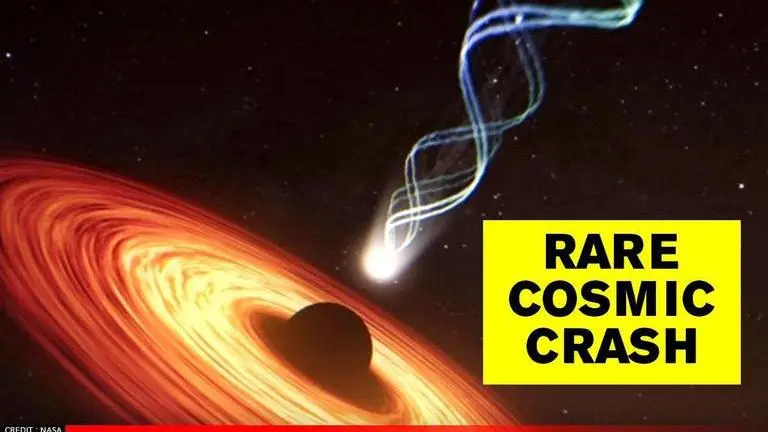Updated 3 September 2020 at 18:27 IST
Scientists detect first-ever rare black holes collision that occurred 7 billion years ago
Instrument managed to pick the “strange” space-time ripples which the scientists found resulted from a lopsided merger after black hole collision.
- Science News
- 3 min read

Scientists have observed a “rare” cosmic crash of two black holes for the first time ever. Astronomers found that a violent collision between unevenly matched black holes was detected by the gravitational wave detectors which occurred last year 2019, on April 12. The instrument managed to pick the “strange” space-time ripples which the scientists found resulted from a lopsided merger after one black hole three or four times more gigantic than first collided with it. Scientists at the Laser Interferometer Gravitational-wave Observatory (LIGO) announced the discovery of the gravitational waves event known as GW 190521 on April 18 at an online meeting of the American Physical Society.
[An artist's depiction of mismatched black holes colliding. (Image credit: N. Fischer, H. Pfeiffer, A. Buonanno (Max Planck Institute for Gravitational Physics), Simulating eXtreme Spacetimes project]
[A still image from a numerical simulation of a black-hole binary merger with asymmetric masses and orbital precession. Credit: Caltech.Edu]
However, the merger that occurred 7 billion years ago was studied in detail and it was found that the energetic bang that created humungous cosmic waves was in fact due to the collision of the two big black holes. In the study, scientists revealed that the collision made a “chirp” which is a lower frequency “loud thud” sound occurring in distant space. A gravitational "shockwave" spread across in the largest merger ever observed in space. It took these waves seven billions of years to reach Earth to be captured by the laser detectors in the US and Italy, last year, researchers said in the study.
Advertisement
BREAKING -
— Dr. Karan Jani (@AstroKPJ) September 2, 2020
Ladies and Gentlemen - We have made the first confirmed detection of intermediate mass black holes with LIGO and Virgo detectors.
An honor of a lifetime to be given a leading role in this historic discovery. #GW190521 pic.twitter.com/xSFsPADBAQ
A sole celestial mass 142 times that of our Sun was created in the aftermath of the collision. While the black holes observed by the scientists were a bit smaller than those observed on the detector, the new findings give scientists a new insight into the novel class of intermediate-sized black holes never previously observed. As per the research, these black holes were composed of mass about 100 to 1,000 Suns, in other words, solar masses.
Professor Nelson Christensen from the Côte d'Azur Observatory in France was quoted saying in a report that the discovery was indeed “astounding”, adding, that the signals travelled through seven billion years which explained that event occurred 'just before halftime' for the Universe.”
Advertisement
LIGO-VIRGO found gravitational waves
The phenomenon was analyzed in detail by the international LIGO-VIRGO collaboration, which operates three super-sensitive gravitational wave-detection systems in America and Europe, according to the study. Between 2015 and 2017, the scientists noted at least 10 mergers during LIGO's first two observing missions. However, LIGO's third observing run in 2019 found the bigger black holes, nearly four times more massive than black holes previously detected,
Frank Ohme, a LIGO scientist at the Max Planck Institute for Gravitational Physics in Germany said in a statement. "It’s clear we are just beginning to understand the diversity of black hole binaries out there, and I am excited to decipher the universe's secrets every day a little more,” he was quoted saying in the statement. Christopher Berry, a gravitational-wave scientist at Northwestern University, wrote in the blogpost that the investigations of connections between Oreos and black hole formation were ongoing and the finding would give scientists a better understanding of black holes “pair up.” GW190521 was one of the 50 gravitational waves that was investigated at the laser laboratories since 2019.
Published By : Zaini Majeed
Published On: 3 September 2020 at 18:27 IST


